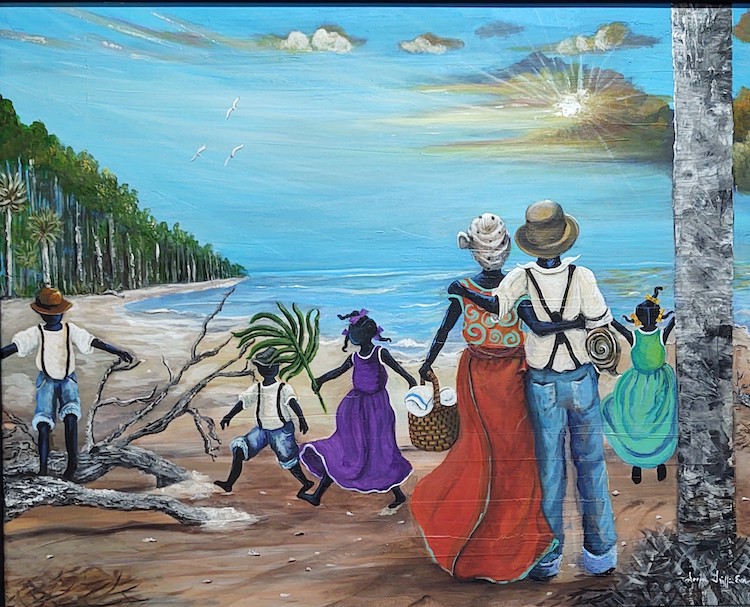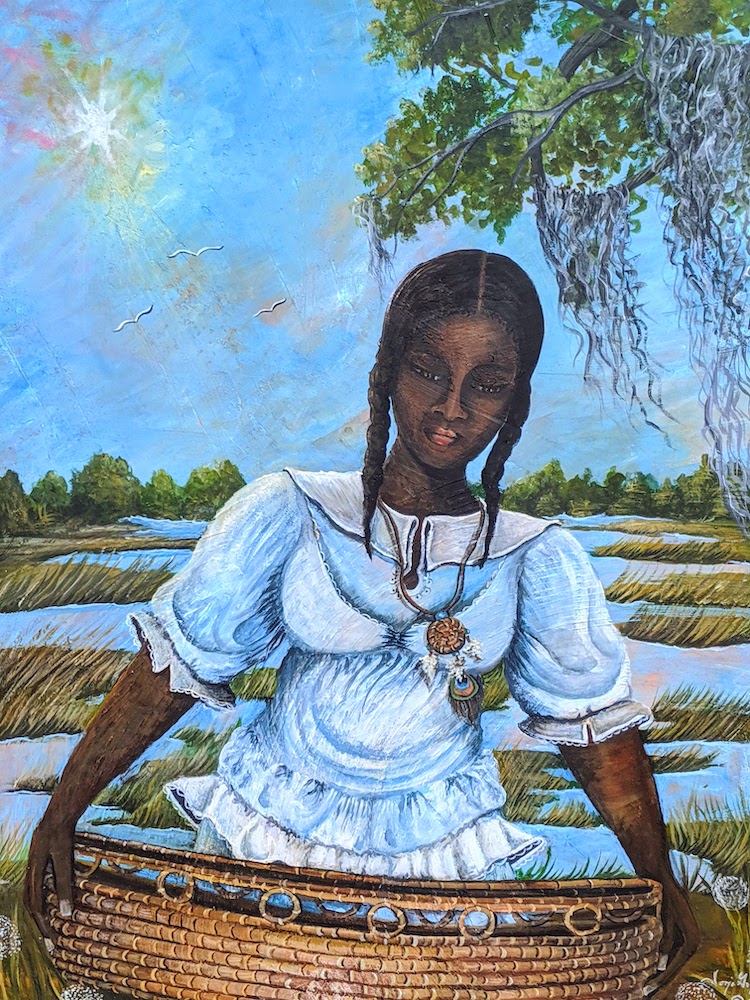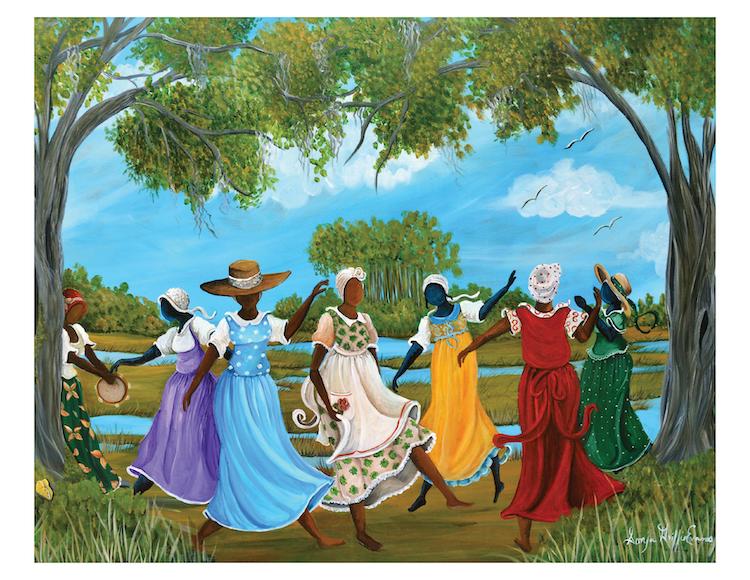Lowcountry native Sonja Griffin Evans has always been inspired by her African American heritage and the culture of the Gullah Sea Islands. Her dedication to preserving their culture and history manifested Sonja’s passion for capturing the Gullah spirit through art. She masterfully depicts the deep history of Gullah Sea Island culture in her artwork with a keen use of vibrant color. The history guides her hand as she shares Gullah’s ancestral stories, reflecting her African descendants’ spirit.

Michiel Perry: Can you describe your early influences that embolden your pursuit of art?
Sonja Griffin Evans: I sold my first portrait in high school. However, it was not until my thirties, that I began painting as a form of therapy. As my art helped me to heal from the inside out, I realized the power of art could translate experiences across space and time. Art is a universal language that we can all understand. The reactions to my work, from those who viewed it, encouraged me to pursue it. When someone purchased my art and told me my work spoke to them in the depths of their soul, I knew that creating art was my purpose and I have to continue.
Michiel: How do you motivate yourself to start your next piece?
Sonja: As I live life, my experiences along the way, begin to inspire the next piece. After I have lived all the moments to complete the piece, my paintbrush brings forth the artistic manifestation of the journey.

“Gullah Beach Day.”
Michiel: What is your favorite connection or experience you have had after finishing a piece of art?
Sonja: Creating and presenting one of my Freedom Doors to Congressman John Lewis in Washington, D.C. was my favorite and most memorable experience. After presenting my painting, Freedom’s Door, to honor him, he wept on my shoulders. He then looked me in the eyes and said, “You made me cry. I will never forget you.” It was a moment in time that allowed me and my art the opportunity to connect and honor a man,who sacrificed so much for so many. Freedom’s Door will always be my favorite and most memorable piece of art.

“Gullah Dream Catcher.”
Michiel: What do you want your art to communicate?
Sonja: I want my art to encourage and inspire others to fulfill their purpose. I want the viewer to stop suddenly, stare quietly, and walk away with a greater hope.
Michiel: Can you describe feedback from one of your art pieces that made you see your art in a different way?
Sonja: One of my collectors expressed that after viewing my art piece, American Gullah, for the first time, it gave him the same overwhelming feeling when he viewed Rodin sculpture ‘The Thinker’ in Paris. He stated that my art felt as if it comes from a deeper place. I then began to see my work not only as Gullah cultural art, but art that transcends cultural boundaries.

“American Gullah.”
Michiel: Do you have other passions that fuel your art?
Sonja: Poetry, storytelling, singing, and interior design.
Michiel: Do you consider different cultural experiences or how your art is perceived over time when creating your art?
Sonja: I believe as Nina Simone, An artist’s duty is to reflect the times. Ms. Simone believed that was true of painters, sculptors, poets, musicians. I also choose to reflect the times and situations in which I find myself. I too believe that is my duty as an artist.

“Freedom Dance.”
Michiel: Can you describe Gullah Sea Island culture and how you incorporate it into your art?
Sonja: Gullah culture derived from the enslaved Africans that were isolated on the sea islands of North Carolina, South Carolina, Georgia and Florida. The Gullahs are said to have preserved more of their African cultural heritage than any other group of African Americans. They speak a blended language, similar to that of Krio spoken in Sierra Leone.
Because of isolation on the sea islands, Gullah farming and fishing communities formed during and after slavery. These African American communities have a cultural heritage treasure trove of traditions that have survived slavery, the Civil War, and the emergence of modern American culture.
In my paintings I portray a strong sense of identity; the Gullah way of living. My art captures subject matters that are skilled in the creation of African styled handicrafts, like sweetgrass baskets, Gullah traditions, and historical contributions of my Gullah ancestors. I desire to create paintings that channel the peaceful sea island landscape and the rich vibrant jewel tone colors of the Gullah sea island culture.

“Long Road Home.”
Michiel: Is there a motivation behind your pieces that show more facial features than your other pieces?
Sonja: When creating my paintings, I unveil the figures and their messages or stories. The figures with facial features are created to communicate with the viewer through the eyes; the windows of the soul. Without the facial features it draws the viewer more into the painting and allows them to use their imagination.
Michiel: How does your faith, personality, and culture impact the art that you create?
Sonja: My Faith plays a vital role in my creative process. I try to create art that deposits into the human spirit. When someone views my art I want them to experience an awakening of their inner man. The figures in my painting represent both physical and spiritual realms.
Each piece that I create reflects a part of my life’s journey. My mood plays a vital role in color selection for each painting. It also determines the body mannerism and the positioning of the figures in my artwork.
My culture is a part of me and with each brushstroke I leave a part of myself in my artwork. I desire to preserve my Gullah culture through art, while helping to educate others on the long-held traditions, values, and contributions of this great American culture.

“Hope.”
Michiel: Do you have a different development process for art that is self-inspired versus art that has been commissioned?
Sonja: The development process is a little different when creating a commissioned piece. I am then creating a piece that is based upon another person’s idea or vision. Self-inspired art has no limits and endless possibilities.
Michiel: Do you have any exciting upcoming projects?
Sonja: Yes, I was recently commissioned to paint the official image for the new Broadway- Bound musical ‘Welcome to the Big Dipper’. The composer, Jimmy Roberts, previously wrote I Love You, You’re Perfect, Now Change, the second-longest-running Off-Broadway musical in history.
Photography courtesy of Lloyd Wainscott.
Michiel Perry is the founder of Black Southern Belle, a lifestyle brand focused on African-American women with a Southern connection. See more of her work for ASPIRE DESIGN AND HOME here!
Like what you see? Get it first with a subscription to ASPIRE DESIGN AND HOME Magazine.
